Parts of a sailing yacht
This table shows the parts of a sailing yacht with the associated technical terms.
As in shipping in general, many technical terms are also used in sailing (see list of nautical technical terms ). The most important technical terms for the parts of a sailing yacht are in the following tables, together with a brief explanation of the function. The corresponding English names, as they are common in international usage, are also listed.
Parts of the boat


This table lists the main components of a sailing yacht. In reality, no two boats are often exactly identical, but these parts can be found in one form or another on the majority of the boats. The numbers are identical in all diagrams so that the positions in the different views can be compared.
| number | German name | Detail picture | Remarks | English name |
|---|---|---|---|---|
| 1 | Mainsail |
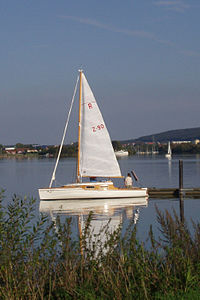 Yacht only with the mainsail set |
A pitched sail with high rigging | main sail |
| 2 | Headsail |  |
The foresail of a single mast is a jib or a genoa | jib or genoa |
| 3 | spinnaker | 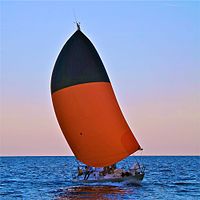 |
Bulbous headsail, instead of jib or Genoa at downwind be used | spinnaker |
| 4th | hull | Classically made of wood, but today almost exclusively made of plastic | hull | |
| 5 | Kiel |
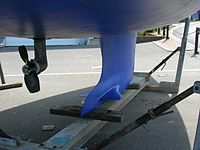 Ballast keel |
Acts of heeling and drift towards and is a prerequisite for the wind to show up to | keel |
| 6th | Rudder |  |
Is connected to the tiller or, on larger ships, to the steering wheel and is used to change direction. A rowing boat is operated with oars in a technically correct manner . | rudder |
| 7th | Propeller with shaft |
 The shaft with the propeller can be seen in front of the rudder |
Today, two mechanically different designs are common: L-drive with straight shaft and saildrive , in which the propeller is attached to a kind of gondola. The propeller is driven by a marine diesel engine and is usually controlled via a single-lever switch in the cockpit |
propeller |
| 8th | Tree vang | Prevents the uncontrolled climbing of the tree on downwind courses. Can be designed as a simple tackle (pulley) or as a so-called rod kicker , which also prevents the tree from falling | vang | |
| 9 | Jib sheets | One sheet each leads from the clew of the headsail to the jib winch (28) on each side. This adjusts the headsail | jib sheets | |
| 10 | Spinnaker pole | Used when driving under spinnaker | spinnaker pole | |
| 11 | Forestay | Secures the mast to the rear, the foresail is also pulled up on it | fore stay | |
| 12 | Shrouds | Hold the mast in the direction of the transept, divided into upper (12a) and lower shrouds (12b). Up to three pairs are common. | shrouds | |
| 13 | Spreaders |
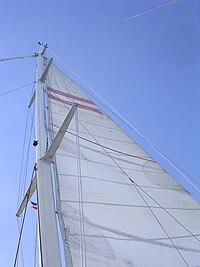 Mast with three pairs of spreaders |
Spread the shrouds apart to optimize the pulling direction of the forces. Larger sailing ships have multiple pairs | spreader |
| 14th | mast | Traditionally made of wood, today mostly made of aluminum or carbon. The latter mainly for racing yachts because of the high price. The mast is either placed directly on the keel through the deck or stands on deck, with a mast support underneath leading through the cabin and absorbing the forces. | mast | |
| 15th | Clicker |  |
Shows the direction of the apparent wind and thus helps the helmsman to keep the optimal course | telltale |
| 16 | Backstay | Secures the mast towards the front, can also serve as a trimming device to adjust the mast fall (curvature of the mast) | standing backstay (the running backstay would be a backstage) | |
| 17th | Large tree |
 Main boom with mainsheet |
Like the mast traditionally made of wood, today mostly made of aluminum | boom |
| 18th | Mainsheet |
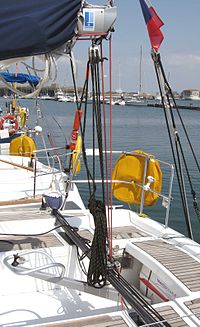 Multiple squat main sheet |
Used to adjust the mainsail, is operated with a pulley block or winch . | main sheet |
| 19th | Dirk | Prevents the tree from falling on the deck when the sail is not set. | topping lift | |
| 20th | Foresail reefing line | Most yachts today are equipped with a furling system for the headsail. The line enables the sail to be rolled in and out safely from the cockpit. | reefing line | |
| 21st | Cunningham straightener | Rarely used auxiliary line to better tension the luff of the main sail | Cunningham rope | |
| 22nd | Big case | Used to set the mainsail. The sail is raised by pulling the halyard | main halyard | |
| 23 | Jib halyard | Used to set the foresail. If a furling system is available, the sail usually remains pre-hoisted and the halyard is no longer needed on the way | jib halyard | |
| 24 | Tiller with rudder stick |  |
The ship is steered with the tiller. Yachts over 10 meters in length usually have one or even two steering wheels instead. | tiller |
| 25th | Pushpit |
 Pushpit with man overboard buoy |
The rear end of the sea fence is often used to attach a life throw device | pushpit |
| 26th | Bathing ladder | Mostly folding ladder attached to the stern to get into or out of the water. Your suitability as a rescue ladder , as it is sometimes called, is controversial, because weak people can often no longer use them. The flapping stern can also injure someone in rough seas. | boarding ladder | |
| 27 | Stern cleats |  |
Used to moor the ship in the harbor | star cleats |
| 28 | Jib winches |
 Several rows of sheet winches on a racing yacht |
One winch each on port and starboard is used to adjust the foresail. Larger yachts can also have separate pairs of winches for spinnaker sheets, cutter sheets or main sheet | jib winches |
| 29 | Plug bulkhead |  |
Wooden or plastic board that is inserted into the companionway to close it or to prevent water from entering | bulkhead |
| 30th | Sliding hatch | Horizontal covering of the companionway. | sliding hatch | |
| 31 | Work winches | The foremost winches, usually on the cabin roof, are called work or halyard winches , as they are used to operate various lines depending on the situation. The ends of the various traps, reefing lines and straighteners end on the cabin roof and are held there by trap stoppers . The line you just need is placed on the winch and pulled (pulled) | halyard winches | |
| 32 | Vorluk | Transparent flap that brings light and fresh air below deck. The hatch can be closed watertight so that no water penetrates even in heavy seas. Can serve as an emergency exit. | hatch | |
| 33 | Bow cleats | bow cleats | ||
| 34 | Pulpit |
 Pulpit with navigation light and foresail furling system |
Front end of the Sea Fence, usually carries the front navigation lights | pullpit |
| 35 | Railing / sea fence | Primarily intended to prevent someone from falling overboard. For seagoing yachts, the railing must be at least 60 cm high and have two passages. Since the railing cannot adequately prevent falling overboard, it is recommended to wear life jackets and a life belt . | railing or guard rail | |
| 36 | Jib sheet guide rail |  |
The sheet runs through a roller that can be adjusted over the rail, so the angle of the sheet to the sail can be adjusted | track for foresail sliders |
| 37 | Traveler | Rail running across the cockpit to which the pulley for the main sheet is attached. Used to trim the sail | traveler | |
| 38 | Ship engine |
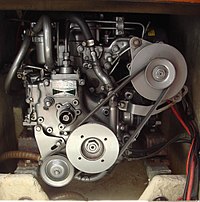 Yacht diesel engine seen from the maintenance hatch |
For safety reasons, yachts are almost exclusively equipped with diesel engines. | main engine |
| 39 | Dog bunk | A bunk built under the cockpit. Larger ships have one or even two full bedrooms aft | quarter berth | |
| 40 | Navigation corner |  |
Chart table for navigation and workspace for the navigator. He typically has a VHF radio , radar, and chart plotter available today . The lights of the ship and other consumers such as cooling units can also be switched from here. Often there is also a display for fuel and drinking water supplies and the battery charge. | |
| 41 | Side bunks | Seating for the crew can also serve as sleeping arrangements. For a good night's sleep during the journey, lee sails are essential (a cloth that is stretched over the bunk) | berths | |
| 42 | Storage options | Various storage options for clothes, equipment and food are arranged as cupboards or as lockable compartments above the side bunks | loosely | |
| 43 | Forward berths | There is usually a double berth in the forecastle. On large yachts, additional cabins can be accommodated in the foredeck | berths | |
| 44 | Anchor locker with collision bulkhead | The anchor chain is stowed in a separate area of the forecastle. A bulkhead immediately behind the chain locker prevents the ship from sinking if the bow is damaged in a collision | anchor loose | |
| 45 | Sea toilet |
 Washroom on board a catamaran. |
The toilet is flushed either manually with a hand pump or electrically. Because the discharge of faeces into the seas near the coast or on inland lakes is mostly prohibited, a collecting container is used that can be pumped out in marinas. | head |
| 46 | Dining table | The table can usually be folded on smaller boats to facilitate access to the forecastle. Rolling strips (raised edges) should prevent things from becoming independent in rough seas | ||
| 47 | Pantry |  |
The food is prepared in the pantry. The stove is usually operated with gas or fuel and is gimbaled so that the pots are level even when they are heeled . There is also a washing facility. | galley |
| 48 | Locker | Storage space accessible from the cockpit for larger items of equipment such as fenders , lines or reserve anchors | loose seat | |
| 49 | bowsprit | Bow extension for attaching additional sails. Here designed as a bathing platform with an additional anchor roller. | bowsprit |
Additional deck equipment
| German name | Detail picture | Remarks | English name |
|---|---|---|---|
| Dinghy |
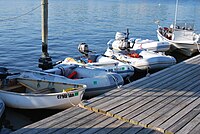 Dinghies at the pier of a harbor |
Used to transfer crew or provisions when the ship is in the roadstead . A rubber dinghy is often used so that it can be stowed well on longer ocean passages. | dinghy (A sailing dinghy is but a dinghy) |
| block | 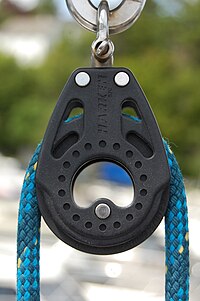 |
A pulley for ropes is called a block . Multiple blocks can be combined to form tackles | block , pulley |
| Latch stopper / curry clips | 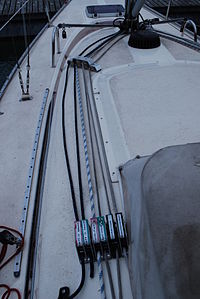 |
Halyard stoppers or curry clips help to fasten lines under load. This is more convenient than having to tie them up every time. | halyard stopper |
| cordage |  |
Ropes are called “rope” or “line” on a ship. They are used for many different purposes, including setting and adjusting sails, or mooring on a jetty. | rope |
Safety equipment
With the expression good seamanship , water sports enthusiasts express that someone steers his boat with responsibility and caution and also pays appropriate attention to the necessary safety equipment. Sailing is a safe sport, but if something goes wrong, the ship and crew are often on their own, as help can be hours or days away. The following table shows some of the items of equipment that are explicitly used for safety and are not self-explanatory - a more extensive list of recommended safety equipment can be found in the corresponding article .
| German name | Detail picture | Remarks | English name |
|---|---|---|---|
| Life jacket with lifebelt | 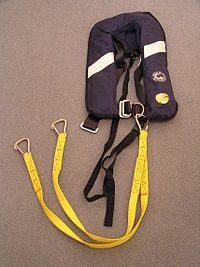 |
Increases the time it takes to rescue a fall overboard. The harness can effectively prevent anyone from falling overboard in the first place. | life west |
| Pütz |  |
A normal bucket with a piece of rope on the handle. Has many uses : scrubbing the deck, putting out fires, draining water | |
| Signal flares , signal missiles | 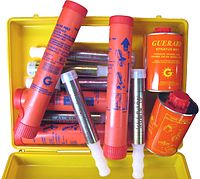 |
Used for signaling at sea, for example in the event of a sea emergency . Pyrotechnic signaling devices are no longer freely available in many places because they are often misused. | emergency flare |
| Radar reflector |  |
A radar reflector can help make a small ship easier to see on other ships' radar screens | radar reflector |
| Life raft |
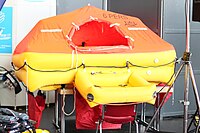 Inflated life raft |
Life raft used for evacuation in an emergency. Neither replaces the dinghy, nor does a dinghy make it superfluous | life raft |
See also
- List of parts belonging to the current asset
- Standing good
- Safety equipment on pleasure boats
- Electric power supply on ships
Individual evidence
- ↑ a b c English names after Schult, Joachim: Segler-Lexikon. Bielefeld: Delius Klasing, (13th edition) 2008, ISBN 978-3-7688-1041-8
literature
Introductory literature:
- Sailing for Dummies , Wiley-VCH, ISBN 978-3-527-70949-6
- Seamanship. Yachting manual. 30th edition, Delius Klasing Verlag , Bielefeld 2013, ISBN 978-3-7688-3248-9 .



